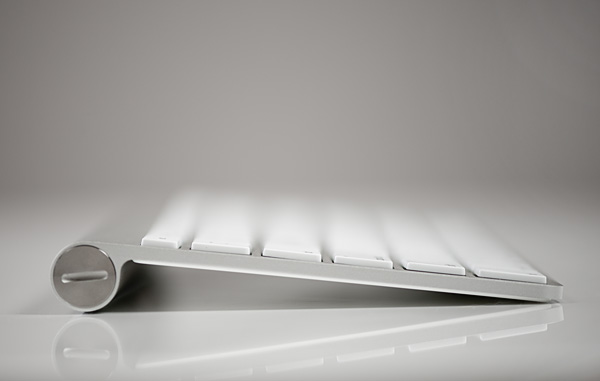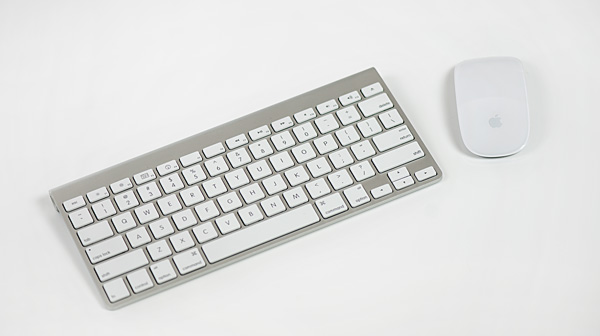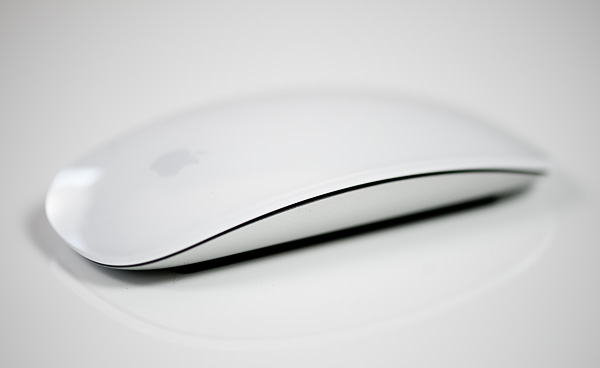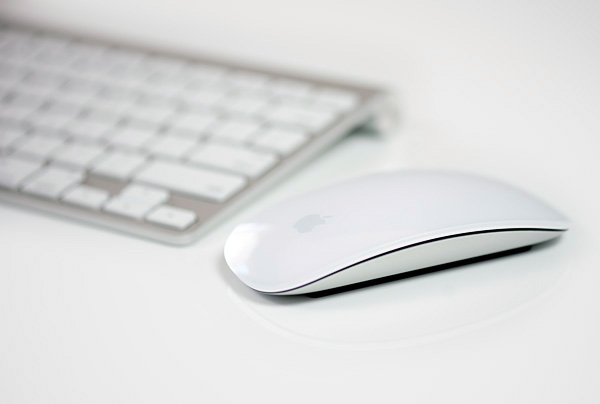The 27-inch Apple iMac Review (2011)
by Anand Lal Shimpi on May 27, 2011 2:30 AM ESTThe Peripherals
I've never been a fan of wireless peripherals - I didn't want more things to charge. Last year I finally broke down and bought a wireless mouse: Microsoft's Wireless Mobile Mouse 4000. I didn't buy it for mobility, I just liked the form factor.
The iMac comes with all wireless peripherals. In fact, if you stick with WiFi for network access, there's only a single cable you need going to the iMac: power. By default you get Apple's Wireless Keyboard and a Magic Mouse.
The Wireless Keyboard is a Bluetooth keyboard that runs off of two AA batteries. It pairs effortlessly with the iMac and I didn't encounter any issues with interference in using it. The keyboard seems to burn through batteries quicker than the mouse, perhaps that's because I type far too much or there's an issue with power management under OS X. After a week of use I'm down to 81% on a fresh pair of batteries (this is my second set).
The keyboard itself is a lot like Apple's standard aluminum keyboard, just wireless and more compact. Apple chopped off the dedicated home/end key island as well as the numeric keypad. Under OS X Cmd + Left/Right Arrow take the place of Home/End for me so part of the sacrifice isn't a problem, but the missing numeric keypad is. I do entirely too much data entry (ahem, benchmarks) to not have a dedicated numeric keypad, and for some reason Apple doesn't offer the Wireless Keyboard with one.
If you don't type tons of numbers every day however, the Wireless Keyboard is really nice. Apple had to stick a function key to the left of the control key, which is a bit bothersome (leave my control/option/cmd row alone) but it's nothing you can't get used to. The footprint is great. I have a giant desk, but I always seem to run out of desk space. The Wireless Keyboard makes it so that I can reclaim a small amount of high value desk area.
Typing feel and keyboard angle are both great - no complaints there. I'm a fan of Apple's keyboards.
Pointing devices designed in Cupertino are another story entirely. I've never liked Apple's mice. It was a big enough problem that when I first tried my Month with a Mac experience I ditched Apple's mouse. There was no way I was going to give the platform a fair shake if I had to use that thing. Since then Apple has at least enabled double clicking - the surface of the Magic Mouse is touch sensitive, click with your right finger and you get a right click. The Magic Mouse has no scroll wheel but drag your finger around on its surface and you get the best scrolling experience on a physical mouse.
The Magic Mouse is also a Bluetooth device that quickly pairs with the iMac. I noticed under Windows there's always a second or two of lag before it recognizes the mouse whereas it's useable as soon as you can see it under OS X.
My complaints about the Magic Mouse are three-fold. As I've mentioned before, the Magic Mouse doesn't have soft rubber feet that glide around on your desk. Instead you get two hard plastic strips that just seem to scrape against all surfaces. Tracking isn't a problem, but it's not a pleasant experience.
The other issue I have is the form factor itself. Microsoft's Wireless Mobile Mouse 4000 is small but it has a nice curve to it that seems to match my hand very well. The Magic Mouse on the other hand doesn't conform to any part of my body. I can lay my hand flat on it but either I'm not conditioned to do that or that's not a very comfortable way to use the mouse for long periods of a time.
Finally there's the clicking noise it makes. Modern mice seem to have a solid but more muted click, whereas the sharp click of the Magic Mouse reminds me of the past decade of Apple mice. I assume that's what Apple was going for, but Apple's market share has grown considerably in the past 10 years - it's ok to let go of some traditions.
Apple does offer the Magic Trackpad as a no-cost option. I have a love/hate relationship with the Magic Trackpad as a pointing device. Scrolling and gestures are great on it, but I prefer a normal mouse for most everything else.
















139 Comments
View All Comments
tipoo - Friday, May 27, 2011 - link
Nevermind me, it was answered in the article.tipoo - Friday, May 27, 2011 - link
I heard that unlike previous iMacs, the new ones can only use another mac with Thunderbolt to use the iMac as a targeted display. Is that true? I wouldn't feel so bad about discarding such a system when the GPU and CPU feel too old in two or three years like Anand mentioned if I could use it as an external display, but I think the new ones are limited to only being used by other Macs. And that's also assuming Mac's in 3 years will use compatible Thunderbolt ports.TegiriNenashi - Friday, May 27, 2011 - link
What is wrong with this display? Just one number: 16:9.QuietOC - Friday, May 27, 2011 - link
I have used a 20" white iMac and 24" aluminum iMac. The later has a big persistent image problem. Evidently IPS pixels don't work well in a hot environment. The low noise level of the iMac is nice to mostly not hear, but the visual noise might be worse.Also the cheap 320GB WD Caviar failed by randomly disappearing which may have be heat related, and the USB ports have also started randomly disconnecting. The mouse and keyboard just stop working during the day and I have to unplug them and plug them back in. So, no, I would not recommend getting a $1000 monitor with a computer mounted inside it.
KoolAidMan1 - Friday, May 27, 2011 - link
I've owned both the 24" iMac you talk about and a 27" from late 2009. Image persistence became a problem with the 24" models, as well as the CCFL losing some of its brightness by the two year mark.The new 27" models do not have either issue. Image persistence has been fixed, and I don't expect there to be any fading since LED backlights don't suffer from the same degredation issues that CCFL backlit displays do over time. On a related note, I have a NEC 2490WUXi as my secondary display. That monitor uses the same 24" H-IPS panel that the old 24" iMac did. It has minor image retention issues, but not to the same degree as the iMac had. Whatever LG did with their new 27" panels seems to have addressed that problem.
zhill - Friday, May 27, 2011 - link
First off, nice article Anand. Well presented and I think your perspective is a common one in this case. I agree that the lack of upgrade options and rather mediocre gpu performance are certainly off-putting for a machine in this price range, but I also think that your observation that if you are willing to spend $1800 for a laptop with a reasonably short lifecycle then the iMac is not much different. I think you've really hit the point there--the iMac's target customer.I would argue that most iMac users are not highly technical, power users. They are people that want a big screen and don't need the portability of a laptop. These people, like my parents, value the simplicity and ease of use of the iMac and the fact that their workspace is often small and would rather it not be covered in cords and cables. In that case not only does the iMac make sense but it's lifespan is substantially longer and all the GPU they need is enough to drive the system and maybe do some video editing. Gaming prowess has never been an apple concern and I doubt it will be until Steve Jobs decides to buy Activision or EA. I do like the iMac from a compute appliance perspective, just plug it in and compute--no fuss. Also, trying to make a reasonable gaming rig with a 2560x1440 display is a fairly daunting task even with today's cards. You would have to be near the top-end and that's a whole lot of power and heat to dissipate in a reasonably small enclosure (considering the size of a 6970 or 580 card by itself).
I also have to say that Intel's recent willingness to keep switching chip sockets has made upgrades far more painful than they should be (yes, I have a core i7-920 with socket 1366 that is now essentially orphaned).
Alberts - Friday, May 27, 2011 - link
Securedoc for Mac from a company called Winmagic supports SSD's with encryption hardware as long they adhire to the opal specification from the trusted computing groupJimmiG - Friday, May 27, 2011 - link
You can't upgrade the hardware and you can't separate the computer from the display so you can keep using the display long after the hardware has become obsolete.That's pretty much the oposite of "green".
Spazweasel - Friday, May 27, 2011 - link
This may be old news (I'm not going to wade through 6 pages of Apple-hating trolls to see), but you CAN use your 27" iMac as a monitor:http://support.apple.com/kb/HT3924
It's called "Target Display Mode".
KoolAidMan1 - Friday, May 27, 2011 - link
Note that it is only talking about the 2009 and 2010 models with mini-DP ports. Those can take an external source so you can use the 27" iMac as a monitor. I use it every day as the primary monitor for my gaming PC.The new 2011 iMacs have different requirements since they switched to Thunderbolt ports. Until an adapter or something comes out, the only sources that can output a video signal to the 2011 iMacs are Thunderbolt equipped computers. For the time being this only limits them to 2011 Macbook Pros and other iMacs (which would be a weird application).
I love the iMacs, but as someone who uses Target Display Mode every day, the new requirements bother me. It won't be a problem in a year or so when Thunderbolt becomes more common, but for the time being it is pretty limiting.